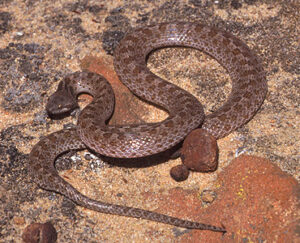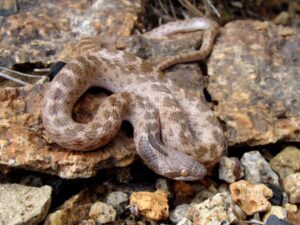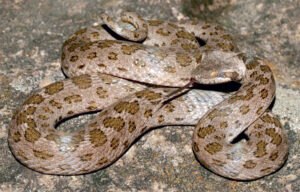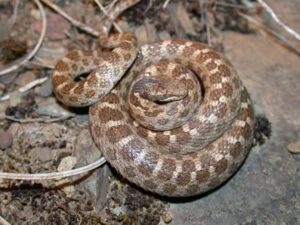The night snake is a rear-fanged colubrid that is both nocturnal and crepuscular (active at dawn and dusk). The small, secretive snake is generally a solitary species.
Scientific Classifications
- Suborder:Serpentes
- Family:Colubridae
- Genus:Hypsiglena
- Species:H. torquata
Conservation Status
Description
Size
The snake’s total length is 12-26 in (30-66 cm). The females are heavier and longer than the males.
Color and Appearance
The ground color of the body is pale gray, beige, or light brown, overlaid with brown or dark gray blotches on the sides and back. There is usually a pair of dark brown blotches on the neck that look like a collar. Hence, its specific name ‘torquata’,meaning collar or neck chain. The head is triangular and rather flat. The pupils are vertical, and the belly is yellowish or white. A dark brown or black bar behind the eyes contrasts against the pale gray or white upper labial scales.
Are They Dangerous to Humans
The night snake is slightly venomous but poses no threat to humans. It uses its venom only to subdue its prey. Still, a snake bite needs prompt medical attention and care. When threatened, it may coil up and thrust its coils at its attacker while flattening its head into a defensive, triangular shape.
As pets, they are docile and easily handled.
Night Snakes at a Glance
Distribution
It ranges from British Columbia, Canada, through the western US to Mexico.
Habitat
It can be found in different types of habitats, including deserts, grasslands, sagebrush flats, woodlands, chaparral, thorn forest, thorn scrub, and mountain meadows. It lives in both sandy and rocky areas and elevations of over 8500ft (2600 m). It also inhabits mammal burrows.
They can be seen at night crossing roads. But they can be found hidden under boards, rocks, dead branches, and other surface litter during the day. They hibernate in winter and aestivate during periods of summer. They are most active from April to October, with their activity usually peaking in June.

Lifespan
They have been known to live more than 12 years in captivity. But their lifespan in the wild is unknown.
Predators
Owls, red-tailed hawks, nocturnal mammals and other snakes consume the colubrid.
Diet
The night snake mainly preys on lizards (mostly side-blotched lizards and their eggs, according to a study in Idaho). They also take frogs, salamanders, large insects, juvenile blind snakes, and rattlesnakes.
Reproduction
Oviparous (lays eggs that hatch outside the body)
After mating in spring, a female lays a clutch of 2-9 eggs from April to August. They hatch in 7-8 weeks, usually in late summer.
Source
reptilesmagazine.com, flickr.com, srelherp.uga.edu, naturemappingfoundation.org








